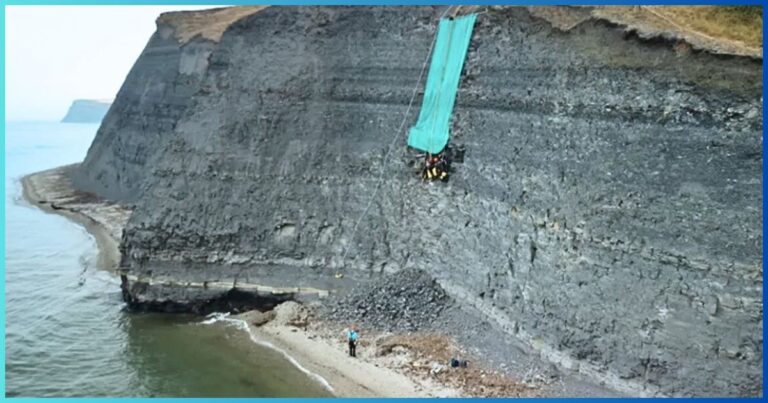
Where there is a head, there is often a body not far behind it. At least, that is usually the case. But as one British paleontologist is finding out, sometimes finding the body of a 150-million year old sea creature isn’t as easy as locating his head was. Steve Etches said the six-foot skull of a marine reptile known as a pliosaur. The skull was found by Philip Jacobs, who got in touch with Etches. Jacobs had found the skull buried beneath British cliffs. But time is running out for Etches to find its body.
“It was very exciting but, thinking logistically, not a good place to collect a fossil from,” Etches said. “The cliffs are sheer, crumbling and unsafe, eroding quickly. It’s a very dangerous area – with large rockfalls and slippery ledges – so safety was paramount.” He said he knows that in those crumbling cliffs, the rest of the skeleton remains.

A British paleontologist is determined to find the rest of a sea creature from 150 million years ago that might be buried under British cliffs, after its 6-foot-long skull was recovered. Photo by BBC Studios
“The rest of the body is without doubt still in that cliff,” he said. “It will take a lot of collaboration and funding, but I’d love to get it out – the cliffs are eroding by a few feet every year and I think it’s important to science that we save the whole thing.”
I stake my life the rest of the animal is there,” Etches said.
“This is a once in a lifetime find,” the paleontologist said. “It is one of the best fossils I’ve ever worked on and I doubt I’ll ever work on anything like it again.” The skull has an impressive 130 teeth, and according to Etches, it likely measured up to 39 feet, with four fins that allowed it to swim fast to prey.
“The lower jaw and the upper skull are meshed together, as they would be in life,” he said. “Worldwide, there’s hardly any specimens ever found to that level of detail. And if they are, a lot of the bits are missing, whereas this, although it’s slightly distorted – it’s got every bone present.”

A rendering of a pliosaur. Photo by BBC Studios
The size of the reptile is incredible, as well, other paleontologists said. “The animal would have been so massive that I think it would have been able to prey effectively on anything that was unfortunate enough to be in its space,” said Dr. Andre Rowe of the University of Bristol.
I do not doubt that this was sort of like an underwater T. rex.”
He will showcase the skull in a museum next year, along with highlighting the extraordinary find on a BBC documentary. “Research-wise it will bring people from all over the world, and I can’t wait for local children and school groups to see it too. For years to come this fossil will be a source of new information and people will come to study it,” Etches said. Watch below for a look at this gigantic skull and the process to unearth it in England.


